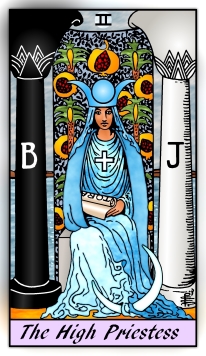When doing a Tarot reading for ourselves, we often find that the chatter of our hopes and fears invariably intrudes. Because of this, it is important to find out how we can silence the voice of our rational mind long enough to enable us to hear our intuitive wisdom. To enable you to do that, I have created a variety of non-divinatory techniques for using Tarot cards to empower you to create the future you want. Here is one that I call “Animating a Card.”
Note: Before reading this, you might want to read my introduction to Tarot Self-Empowerment Techniques.
Any Tarot card can act as a focal point for allowing your intuitive mind to speak to you. Doing a guided visualization is one way to use a card to do this for you, and this technique is a quick and simplified alternative to doing that. In it, you will tell your rational mind that a figure in a Tarot card will be giving you words of wisdom. Since your rational mind is usually more willing to sit back and listen to someone else than it is to listen without interruption or criticism to the quiet voice of your own intuition, this is an effective way to access the subtle, intuitive advice of your higher self.
STEP 1: Pose the question
The first step is to think of an issue on which you want guidance. Carefully consider the nature of the problem or issue at hand and formulate a question about it that will (hopefully) lead to an empowering discussion of possible solutions. Here are some key considerations for a well-phrased question.
First, does it focus on you and not on other people? Since, in the long run, you can only change yourself, a question is most helpful if it focuses on you. For example, questions like, “Is my boyfriend cheating on me?” are not nearly as helpful as something like, “What do I need to know in order to improve my relationship with my boyfriend?” or, “What do I need to know about how to manage my relationship?” In addition, questions like “Is my boyfriend cheating on me?” tend to encourage your rational mind to intrusively speak up on behalf of your ego, championing your hopes or defensively expressing your fears.
Next, does your question reflect your responsibility for your life? For example, “Should I …?” questions are designed to avoid responsibility for making your own decisions. Thus, a question like: “What do I need to know about my career choices in order to help me make the best decision?” is more responsible, as well as more empowering, than a question like, “Which job should I take?”
Finally, does your question empower you to positively affect your future? Asking whether or not something is going to happen implies that you are powerless to affect your future, and ultimately it is of limited use. Knowing that something you want is going to happen does not ensure that you will be able to deal with it appropriately, and knowing that something you do not want is going to happen does not help you cope with it. Ask instead, “How can I make this happen?” (or “How can I keep this from happening?” if it is something you do not want to happen). This will empower you to create the future you want.
STEP 2: Pick a card

The next step is to choose a card with which to do this process, and there are several ways to make that choice. You can logically consider which card would be most appropriate, you can intuitively pick a card while quickly looking through the deck (cards face up), or you can use the divinatory method of dealing yourself a card at random.
A caveat about choosing a card, however, is that this particular procedure works best if the person depicted in the card is facing out toward you. This is not necessary, but until you get proficient at this process, you might want to ensure that you choose such a card by using a rational approach.
STEP 3: Form a mental imprint of the card
Begin by getting a clear mental image of this card, everything from its physical details to its mood and atmosphere. This step will focus your concentration on the card by forcing you to pay attention to all the details in it.
Start off by describing the people depicted in the card. How are they positioned? What are they doing and wearing? What are they holding? Describe any other objects such as props or animals, as well as the background scenery. Also, make note of the predominant color in the card, and consider what objects or symbols seem to command your attention.
Next, describe the mood, atmosphere, and feeling of the card. How do you feel when you view it? Does it make you fearful, melancholy, depressed, cheerful, excited, or peaceful? What is the overall ambiance of the card? Is it one of celebration, contemplation, conflict, or sorrow? What emotions do the figures in the card seem to be expressing? Are they happy, sad, miserable, triumphant, or blissful? Considering these questions will bring you deeper into the spirit of the scene in the card.
STEP 4: Activate the image
Once you have made the image on this card as real to you as possible through the description process in the prior step, relax and gaze at it. Explain your problem to the person in the card and ask for his or her guidance. Then wait a moment for them to reply.
This is the tricky part. To make this process work, it helps to imagine that the card is like your television screen displaying a paused image from a movie. Then imagine that you have “unpaused” the video so that now it is playing again.
The result of this technique varies from person to person. Some actually see and hear the figure in the card speak to them, as if they are in a hallucinatory trance. For me, the result is that I know what the figure is saying without actually hearing it, although there is often an accompanying vague notion of movement in the figure. Experiment with this and see how it works for you. You can also engage in a dialogue with the figure in the card, so feel free to ask for clarification of anything that she or he says.
When your conversation is complete, thank the person in the card. Then imagine that you have once again paused the video, and see this person return to being a static figure in a card. Finally, take a few deep breaths and refocus your attention on yourself and on your immediate environment.
STEP 5: Record the experience
Upon completion of this process, it is important that you immediately write down as much about it as you can, including your thoughts about what it meant to you. This is because a guided visualization is similar to a dream, and like a dream, if you do not write it down quickly, it will soon begin to evaporate, forever to elude your conscious grasp of it.
First, write down a narrative of the experience. Include mention of what you saw, heard, smelled, felt, and tasted, as well as what happened around you. Next, note the results of your interaction with the figure in the card. For example, what advice did you get? Was there any further discussion about that advice? How does the advice relate to your life right now or to the specific problem or issue you wanted addressed? Did your discussion with the figure in the card reveal any positive qualities that you want to have? If so, write a statement that you already have those qualities, and you can use this affirmation to reinforce your acknowledgment of this fact.
Finally, what else came up in your conversation with the figure in the card? Did anything interesting, noteworthy, strange, or surprising happen? If so, what do you think that might mean?
So there you have it — a quick and effective way to use a Tarot card to access the subtle, intuitive advice of your higher self.
.
.
.
.
.
.
.
.
.


